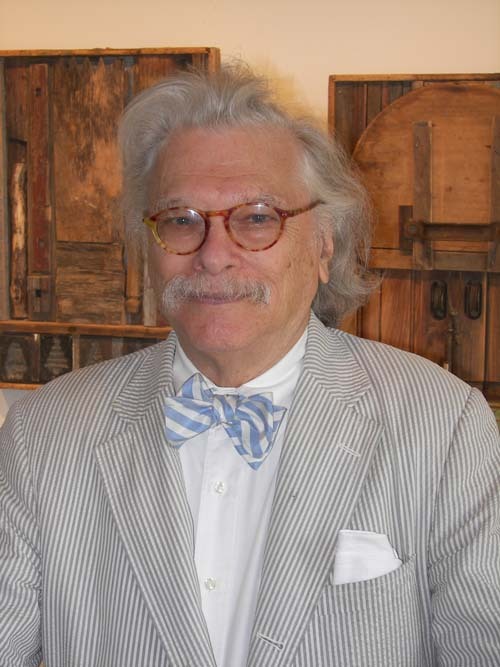
Morris Nathanson has certainly made a lot of news lately. The Exchange Street Bridge in Pawtucket was named for him recently, he was honored by the Blackstone Valley Tourism Council and he’s taking part in the ongoing FirstWorks Festival based in Providence. He is a tireless advocate for Pawtucket, calling it his “urban garden” where new ideas can be cultivated. “Some things you plant take much more patience than other things, but you have to plant the seed,” he said, “and just hope these things will grow.”
Nathanson recently spoke with Providence Business News about his design business, the state of the art world and what can be done to rejuvenate downtown Pawtucket.
PBN: How did you come to establish your design business in Pawtucket?
NATHANSON: For the first 25 years of my career, my office was in Providence. I renovated an old firehouse in Providence. Then there came a time when we outgrew the space and, at that time, much of the design work included local artists and artisans. We wanted to incorporate their work in our designs. Then … [we found] this old mill with enough space in Pawtucket and, lo and behold, it was directly across from my old high school [East High School, now Tolman] and on the same street, Exchange Street.
To make this happen, we had to have a major zoning change for legal reasons. Until [1985], artists and craftsmen were in all sorts of spaces in the state, but it was not legal to live there, in old department stores, in old mills, and whatnot. So, Pawtucket changed the zoning to make this legal for what we now call work/live-in [spaces]. It’s been a very successful concept and it’s really helped to bring creative people to Pawtucket.
PBN: So you’ve never wanted to move your office anywhere else?
NATHANSON: I didn’t move into Pawtucket thinking I was going to get so involved in community activities and in doing so much work with the community. Once I was here, and because the city was so agreeable and cooperative to the things that we wanted to do, I felt it was time to really offer my efforts to help the city in any way I could. The wonderful people in my design studio have been so great in giving me the time to participate in these activities. … I would not be able to do all the work that I did for the community, in the community, if it weren’t for the people in my office.
NATHANSON: First of all, you have the stock, the living stock, the home stock, the mills, you have these great spaces. And there is no space for a working artist any better than what they call mill construction, which includes high ceilings, large windows, plenty of light.
The physical part is important, but beyond that, even more important is that there is something in the air here which just reeks of blue-collar workmanship. It’s so connected to labor, and not just because of the Slater Mill and whatnot. There’s a working class here that’s always been here and probably always will be because of the major immigration we have here. You feel it in the air, you feel it in the people. I actually refer to it in a very positive way as “creative grit.”
There’s nothing gentrified about the area, nor do we want it to be that way. … There’s too much hype in the art world, you know, your Andy Warhols and your superstar artists and socially more with advertising and Madison Avenue than with labor. But your real artists, your real good artists, they are working people. … I think we’ve gotten too far away from that and, in Pawtucket, I think we’re still there.
NATHANSON: The highway [Interstate 95] destroyed all the neighborhoods. … The problem was, I-95 separated the neighborhoods from the downtown, so if you didn’t have a car, you couldn’t get downtown. And then of course when the malls came in, that was the finish. …
Could downtown Pawtucket be revived? Absolutely. However, it can only be revived if the connection were reinstated with the community. In other words, it has to be a walking city again, so that people have the ability to walk from the neighborhoods to downtown. The solution cannot be to drive downtown and then remove all the buildings there to create parking spaces. …
You do not have to start from scratch. You have to go back to the original downtown, see how it was connected to the neighborhoods, and you have to bring density to the area. If you don’t bring density [in the form of more stores, eateries and residences] and connection to the neighborhoods, downtown will never work. …
We’re trying to have [R.I. Department of Transportation] create a bus connection to the [Mass. Bay Transportation Authority] stop that is only five minutes away on the Attleboro-Pawtucket line, which will allow people living in Pawtucket to just get on the MBTA and go to Boston for very little money.
PBN: Over the years, many people have proposed many plans for Pawtucket, yet few seem to materialize. Why is that?
NATHANSON: There are so many people who have brilliant ideas. … But the problem we have here in Pawtucket is we don’t have any muscle behind us to make it happen, meaning government. Almost all of us have other projects, we have jobs to do, we have families to take care of, but we’re still trying to commit our lives to make this very sensitive city better. •
INTERVIEW
Morris Nathanson
POSITION: Founder and president of Morris Nathanson Design
BACKGROUND: He and his firm are responsible for designing 10 restaurants at Euro Disneyland in Paris, promenade decks for Royal Caribbean, many eateries throughout the nation and world, along with such local sites as The Capital Grille, Hemenway’s, Mills Tavern and Ruth’s Chris Steak House. He has been an instructor at Rhode Island School of Design, helped establish and designed scenery for Trinity Repertory Co., and was executive director of the Johnson & Wales University Culinary Arts Museum, where he designed the museum complex.
EDUCATION: Bachelor of fine arts degree, 1949, University of Miami at Coral Gables; honorary doctorates from Johnson & Wales University and Rhode Island College
FIRST JOB: At age 9, worked on his father’s fruit truck
RESIDENCE: Providence
AGE: 83











